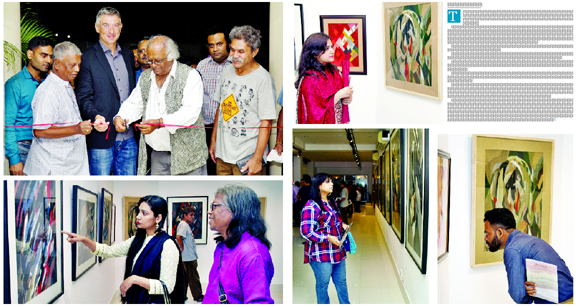
Sheikh Arif Bulbon :
apestry is a form of textile art, traditionally woven by hand on a loom. Tapestry is weft-faced weaving, in which all the warp threads are hidden in the completed work, unlike cloth weaving where both the warp and the weft threads may be visible.
According to the Wikipedia, tapestry is a form of textile art, traditionally woven by hand on a loom. Tapestry is weft-faced weaving, in which all the warp threads are hidden in the completed work, unlike cloth weaving where both the warp and the weft threads may be visible. In tapestry weaving, weft yarns are typically discontinuous; the artisan interlaces each coloured weft back and forth in its own small pattern area.
It is a plain weft-faced weave having weft threads of different colors worked over portions of the warp to form the design.
Most weavers use a natural warp thread, such as wool, linen or cotton. The weft threads are usually wool or cotton but may include silk, gold, silver, or other alternatives.
A solo tapestry and painting exhibition by Tajul Islam titled ‘Composition of Forms and Colours’ was held at La Galerie, Alliance Française de Dhaka in the capital’s Dhanmondi area recently.
Eminent architect and poet Rabiul Husain attended the opening ceremony as the chief guest. There are around 33 tapestry artworks and 32 paintings were on display in display in the exhibition.
Tajul Islam was born in 1946 at Shariatpur. From 1965 to 1979, Tajul Islam spent 14 years with Rashid Chowdhury – known as a pioneer in tapestry art in Bangladesh – in his studio honing the craft of creating compelling and beautiful tapestries. One look at Tajul Islam’s creations and it is understandable that he takes after Rashid Chowdhury.
Though the influence is there, it does not overpower Islam’s unique kind of coloured stripes, imagery or visual language. The septuagenarian artist is still active and beaming, creating inspirational tapestries full of life and movement. Featuring tapestries and paintings, the theme for this exhibition is ‘Inventing the Creative Beauty.’ Tajul’s canvases or screens were full with colorful forms and black-white-red-yellow-blue-green patches those express various conceptions and perceptions of aesthetic human realization.
apestry is a form of textile art, traditionally woven by hand on a loom. Tapestry is weft-faced weaving, in which all the warp threads are hidden in the completed work, unlike cloth weaving where both the warp and the weft threads may be visible.
According to the Wikipedia, tapestry is a form of textile art, traditionally woven by hand on a loom. Tapestry is weft-faced weaving, in which all the warp threads are hidden in the completed work, unlike cloth weaving where both the warp and the weft threads may be visible. In tapestry weaving, weft yarns are typically discontinuous; the artisan interlaces each coloured weft back and forth in its own small pattern area.
It is a plain weft-faced weave having weft threads of different colors worked over portions of the warp to form the design.
Most weavers use a natural warp thread, such as wool, linen or cotton. The weft threads are usually wool or cotton but may include silk, gold, silver, or other alternatives.
A solo tapestry and painting exhibition by Tajul Islam titled ‘Composition of Forms and Colours’ was held at La Galerie, Alliance Française de Dhaka in the capital’s Dhanmondi area recently.
Eminent architect and poet Rabiul Husain attended the opening ceremony as the chief guest. There are around 33 tapestry artworks and 32 paintings were on display in display in the exhibition.
Tajul Islam was born in 1946 at Shariatpur. From 1965 to 1979, Tajul Islam spent 14 years with Rashid Chowdhury – known as a pioneer in tapestry art in Bangladesh – in his studio honing the craft of creating compelling and beautiful tapestries. One look at Tajul Islam’s creations and it is understandable that he takes after Rashid Chowdhury.
Though the influence is there, it does not overpower Islam’s unique kind of coloured stripes, imagery or visual language. The septuagenarian artist is still active and beaming, creating inspirational tapestries full of life and movement. Featuring tapestries and paintings, the theme for this exhibition is ‘Inventing the Creative Beauty.’ Tajul’s canvases or screens were full with colorful forms and black-white-red-yellow-blue-green patches those express various conceptions and perceptions of aesthetic human realization.

